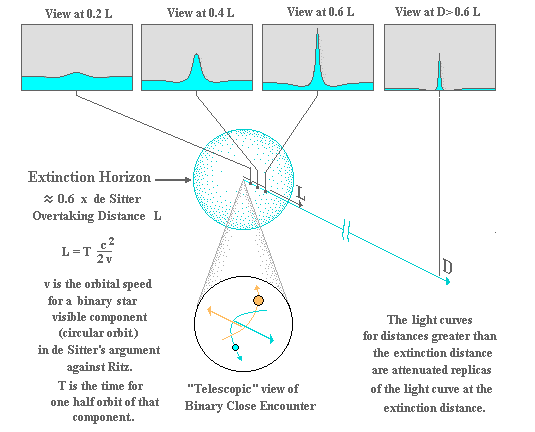If the above scale of things turns out to be valid, then large-area cosmic ray detector arrays, including the Pierre Auger Project, with arrays under construction in both Northern and Southern hemispheres, will be incapable of defining the edges [] of UHECR footprints. (Lumpiness in the distribution of secondary particles, will have to be discriminated from true footprint edge effects.) If unambiguous UHECR edges/footprints are not found then we must dispense with the idea of single-primary-particle UHECRs. Cosmic rays may constitute a new test between Einstein's constant speed of light and Ritz's variable speed of light theories of relativity.
The following paragraphs are copied from Stellar Gamma-ray Flashes. They migrated to that page on 17 January 2002 from the basic article A Ritzian Interpretation of Variable Stars. (Migrations are a fact of life in web-page land.)
The (remote) arrival-time information-compressions that accompany perihelion passages can produce short duration spiked showers of cosmic rays (on the order of milliseconds) where the Fox extinction distance is on the order of 0.5 to 0.7 times the Ritz/de Sitter c+v overtaking distance. [Strictly speaking we should say the c'+v overtaking distance, where c' is less than c.] (The extinction phenomenon fixes or freezes the c'+v effects for distances greater than that for extinction.)
The following graph shows a close encounter of two stars which could lead to gamma ray flashes and Ultra High Energy Cosmic Ray flashes. Light curves for the blue component are shown for increasing distances from the encounter. For this example a Fox extinction distance equal to 0.6 times the de Sitter overtaking distance is used. (For simplification I specify that extinction, in this example, occurs at the stated distance.)

The following three paragraphs were originally installed on 7 February 2002 in the article Stellar Gamma-ray Flashes.
F.W. Stecker and Sean Scully, of NASA Goddard Space Flight Center, claim that gamma ray bursts cannot produce observed cosmic rays above ~10 EeV (EeV = 10exp+18 eV). They say that energy losses suffered by ultra high energy cosmic rays by meson-producing interactions with photons of the big-bang relic background radiation would have a profound effect on what we can "see." (This is the Greisen-Zatsepin-Kuzmin (GZK) cutoff problem. Ivan Semenuik, Sky & Telescope, March 2003, reports the GZK cutoff as being around 5 x 10exp+19 eV.)
The Ritzian time-compressions, hypothesized for close counters of stellar bodies, would also time-compress whatever cosmic rays that happened to be headed our way from the source. (The close encounter of the stars might also accentuate the cosmic ray emission process.) Since the cosmic rays should be traveling slightly slower than the speed of light, we should see cosmic ray bursts which lag their associated gamma ray bursts by times that are directly proportional to the distances from their sources to us.
Since, according to the Ritzian hypothesis, the non-intrinsic sources of gamma ray bursts can be in our own Milky Way neighborhood, we should expect to see cosmic ray bursts with no high energy cutoffs.
(The next four paragraphs were added to Stellar Gamma-ray Flashes on 17 August 2002.)
With regard to a possible connection between cosmic-ray bursts and Gamma-ray bursts, the reader's attention is called to John G. Cramer's "Alternate View" column Ultra-Energetic Cosmic Rays and Gamma Ray Bursts which appeared in the January 1996 issue of Analog Science Fiction & Fact Magazine.
Cramer cites two studies which suggest possible common sources of ultra-energetic cosmic rays, presumably single protons, and specific gamma ray bursts. (There were appreciable time delays between the GRBs and the candidate cosmic-ray events. Cosmic rays travel slower than light.) He calls attention to the amazingly large energy of these primary particles and the heroic proportions of the large collecting volumes for the Earth's surface detectors being used.
The idea of ultra energetic single-particle cosmic-ray primaries, which has been a long-standing perplexity, prompts the following questions. How do you pack that much energy into single primary particles? What evidence compels us to think that all of, or the majority of, cosmic-ray primaries are single particles? Could we actually be dealing with multi-particle bursts/showers? For example, has anyone ever established the actual Earth-surface boundaries of really high-energy secondary showers? The Pierre Auger Project is a good step in the direction of answering these questions.
According Ritz's c+v hypothesis, some cosmic-ray showers/bursts (multiple primary particles) should have frontal areas much larger than the solar system's diameter and their time-wise intensity envelopes should be similar to those for Gamma-ray bursts. The average lateral spacing between primary particles might be on the order of one kilometer (That's a guess.) and the energy per individual primary particle would be modest to low. (The small sized space-borne detectors currently in use might not even see the bursts of primary particles.) The bottom line is that Earth-bound observers could expect to occasionally detect full hemispheric cosmic-ray showers (secondaries), the summed effects of which would naturally represent tremendous amounts of energy. If such events never come to be witnessed it will bode ill for the Ritz hypothesis.
Recommended reading
Astronomers link X-ray
flashes to gamma-ray bursts Los Alamos National Laboratory News Release - 24 April 2002 - SpaceFlight Now.
Evidence for the Galactic Origin of Gamma-Ray Bursts - B. M. Belli - Istituto di Astrofisica Spaziale, CNR, Italy.
References
(1) V.I. Sekerin, Contemporary Science and Regularity in its Development, 4, 119-123, (1987) Tomsk University (In Russian.). For an English translation, see http//www.datasync.com../sekerin.htm.(2) J.G. Fox, Am. J. Phys. 33, 1, 1965.
(3) R. Tolman, Phys. Rev. 31, 26 (1910); ibid. 35, 136 (1912).
(4) W. Ritz, , (1908) Ann. de Chim. et de Phys. 13, 145-275. For an online English translation of [] this article see: Critical Researches on General Electrodynamics.